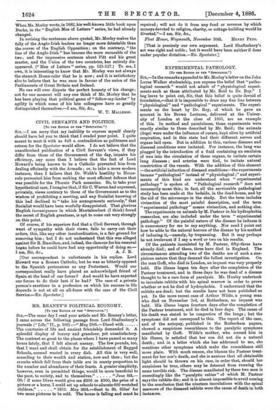EXPERIMENTAL PATHOLOGY.
[TO THE EDITOR OP THE "SPECTATOR."]
Sia,—In the remarks appended to Mr. Mozley's letter on the John Lucas Walker studentship, you express the belief that "patho- logical research" would not admit of "physiological experi- ments such as those attributed by Mr. Reid to Dr. Roy." I beg leave to point out, Sir, that this belief is quite devoid of foundation,—that it is impossible to draw any fine line between "physiological" and " pathological " experiments. The experi- ments on the heart by Dr. Roy, of which he gave an account in his Brown Lectures, delivered at the Univer- sity of London at the close of 1883, are an example of this. In method and painfulness, these experiments were exactly similar to those described by Mr. Reid; the animals (dogs) were under the influence of curare, kept alive by artificial respiration, and in this state had their different nerves and organs laid open. But in addition to this, various diseases and diseased conditions were imitated. For instance, the lung was plugged by the introduction of a fluid containing an emulsion of wax into the circulation of these organs, to imitate certain lung diseases ; and arteries were tied, to imitate natural constriction of the vessels. With the addition of this element —the artificial induction of diseased conditions—the experiments became "pathological" instead of " physiological ;" and experi- ments of this kind are understood when " experimental pathology" is spoken of. "Pathological research" does not necessarily mean this; in fact, all the serviceable pathological study has been made at the bedside, in the dead-house, and by the aid of the microscope in the study. But the term includes vivisection of the most painful description, and the term "experimental pathology" means vivisection, and nothing else.
The experiments on animals by M. Pasteur in his hydrophobia researches, are also included under the term " experimental pathology." Of the painful nature of the disease he induces it is unnecessary for me to say anything. Nor need I point out how he adds to the natural horrors of the disease by his method of inducing it,—namely, by trepanning. Bat it may perhaps be not irrelevant if I say a word or two on his results.
Of the patients inoculated by M. Pasteur, fifty-three have already died ; and of these, three have died in England. The circumstances attending two of the deaths are of such a sus- picions nature that they demand the fullest investigation. On the man Goffi, who died in London, an inquest was very properly held. His illness began ten days after the completion of the Pasteur treatment, and in three days he was dead of a disease thought to be a rare form of paralysis. Mr. Huxley undertook to inoculate rabbits with his spinal marrow in order to prove whether or not he died of hydrophobia. I understand that the rabbits are dead; but the results have not been published as yet. In the more recent case of Arthur Wilde, a young man who died on November 3rd, at Rotherham, no inquest was held. His illness began fourteen days after the completion of the Pasteur treatment, and he died in four days. The cause of his death was stated to be congestion of the lungs ; but the symptoms did not correspond to this. The report of the case, and of the autopsy, published in the Rotherham papers, showed a suspicious resemblance to the paralytic symptoms manifested by Groffi. Wilde's mother, who nursed him in his illness, is satisfied that her son did not die a natural death ; and in a letter which she has addressed to me, she mentions other symptoms which make the resemblance still more plain. With much reason, she blames the Pasteur treat- ment for her son's death, and she is anxious that all obtainable light should be thrown on his case, in order that, should her suspicions be true, others may be deterred from running the same terrible risk. The disease manifested by these two men is exceedingly like the "paralytic rabies" of which M. Pasteur says the rabbits die ; and it is almost impossible to avoid coming to the conclusion that the nineteen inoculations with the spinal marrows of the diseased rabbits were the cause of death in both instances. This, Sir, is a sample of the results we may look forward to if studentships in experimental pathology are to become the
15 St. George's Terrace, Gloucester Road, S.W .







































 Previous page
Previous page